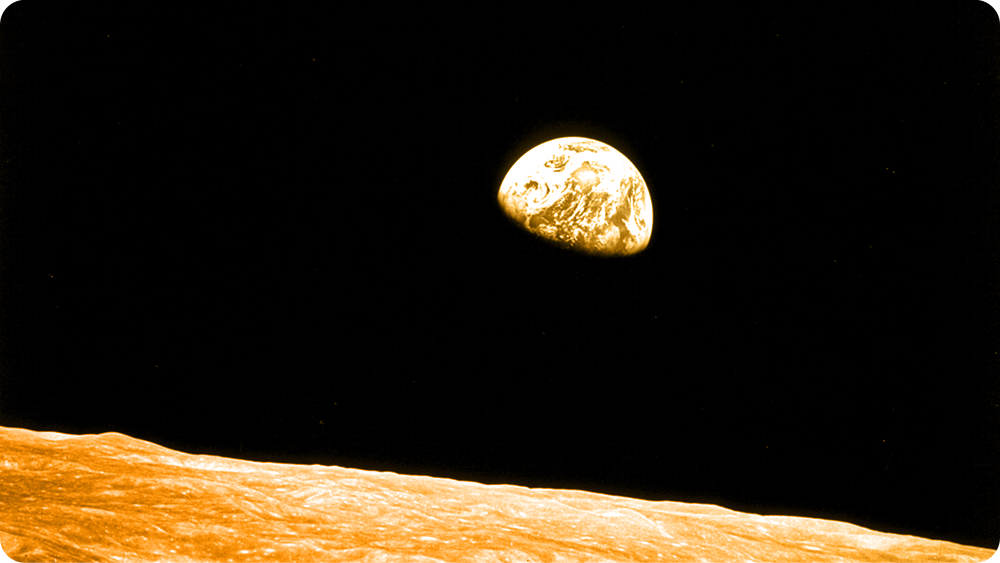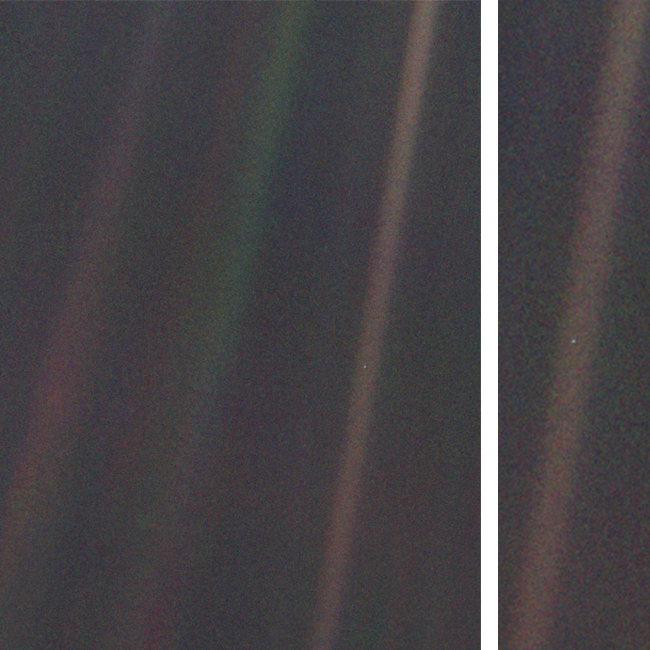the great tiny dot...

There are times when we run low on human spirit and are in no mood to listen to any advice of goodness and collective empathy. All words appear nothing more than a flair of useless fancy. And we find ourselves questioning, “Does it even matter?”
Hmm…yeah…how does one deal with this?
To be honest, we really can’t deal with such a low phase on our own. We need to look around for some inspiration to pull ourselves up back again. And if we are truly fortunate (which I believe we mostly are), we stumble upon something magical along our way – something which recharges our kind spirit right up to its greatest form.
Back in September 1977, NASA launched Voyager 1 into space. Its purpose was to be our eyes in the unforeseen vastness of space, of which we had no previous visual clue. Through Voyager 1 we, the human kind, got to know how Jupiter and Saturn look like, what is their weather like, and most amazing of all – what are their rings like. Not just these two, we go to learn about all other planets and their respective moons too. We got to see the amazing blue color of Neptune. That too, in high resolution.
While Voyager 1 transmitted all this wonderful data back to us on Earth, it had another magical purpose too. On board it carries the Golden Record – a 12-inch gold plated copper disk which contains an assortment of 115 images, various sounds – ranging from animals, birds and whales to thunderstorm, and wind, music spanning different eras of different cultures, and also spoken greeting messages – in around fifty languages – from us Earthlings. For whom, you ask? Well it is meant to be played only if encountered by another civilization in space. This record, if I may say, is a bespoke introduction to the life on Earth for our extraterrestrial friends out there.
This Golden Record was the brainchild of the famous astronomer and author, Carl Sagan and holds a significant place in the history of our universe.
Okay, so you bring this Voyager thing up to make us believe in the essence of human existence?
Let me continue, will you?
Later in 1990, Voyager 1 was tasked with capturing a series of images of the solar system – aptly named the Family Portrait. The idea was to capture the planets as individual frames with their backgrounds to depict their relative position in space. These frames were then stitched together into a picture as a mosaic, showing our solar system as a whole.
The feat was completed at a record distance of 6 billion kilometers from Earth and once the spacecraft was done capturing the planets, it was ordered to exit the solar system with its cameras shut down (preservation of resources, after all, is a great concern in space expeditions).
It was at this point that the idea of also including Earth’s portrait in the bigger picture occurred to Sagan and being part of Voyager 1 imaging team, he put up the request so that an official "go ahead" could be given to take one last picture. That of our very own planet. This, for sure, wouldn’t have been this easy as it sounds right now but Mr. Sagan’s efforts paid off and the approval finally came through. The cameras were turned around and what happened next was a milestone in itself – the Earth was photographed from a distance of 6 billion kilometers through the mystical depths of space!

The image was later titled Pale Blue Dot by Carl Sagan because, yes, that teeny tiny pale blue dot you see in that last sun beam is our beloved Earth. And yes, you are sitting somewhere on that bright little pixel right now.
Four years later in 1994, Carl Sagan presented this image at Cornel University in public lecture. I never get tired of reading his words:
We succeeded in taking that picture, and, if you look at it, you see a dot. That’s here. That’s home. That’s us. On it, everyone you ever heard of, every human being who ever lived, lived out their lives.
The aggregate of all our joys and sufferings, thousands of confident religions, ideologies and economic doctrines, every hunter and forager, every hero and coward, every creator and destroyer of civilizations, every king and peasant, every young couple in love, every hopeful child, every mother and father, every inventor and explorer, every teacher of morals, every corrupt politician, every superstar, every supreme leader, every saint and sinner in the history of our species, lived there — on a mote of dust, suspended in a sunbeam.
The Earth is a very small stage in a vast cosmic arena. Think of the rivers of blood spilled by all those generals and emperors so that in glory and in triumph they could become the momentary masters of a fraction of a dot. Think of the endless cruelties visited by the inhabitants of one corner of the dot on scarcely distinguishable inhabitants of some other corner of the dot. How frequent their misunderstandings, how eager they are to kill one another, how fervent their hatreds.
Our posturings, our imagined self-importance, the delusion that we have some privileged position in the universe, are challenged by this point of pale light .
So, taking you back to the original point, does any empathy, any goodness really matter in such nothingness?
In contrast to the vast expanse of space, imagine the scale of your existence on that ‘Earthly’ spot – that too, with all your individual ambitions, all that you ever want to achieve, every milestone you have already conquered, all the personal space you claim around yourself. In such nonexistence, all that really matters is coming together with as less prejudices as possible. Carl chose to end his address like this:
To my mind, there is perhaps no better demonstration of the folly of human conceits than this distant image of our tiny world. To me, it underscores our responsibility to deal more kindly and compassionately with one another and to preserve and cherish that pale blue dot, the only home we’ve ever known.
Experience the full body of Carl's lecture below.
Happy living!

Member discussion